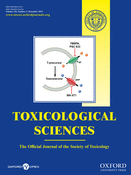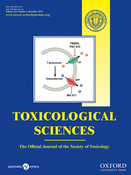
Cover image

Volume 136, Issue 2, December 2013
FORUM
SOT Symposium Highlight: Translatable Indicators of Testicular Toxicity: Inhibin B, MicroRNAs, and Sperm Signatures
BIOMARKERS OF TOXICITY
Reactivation of Plasma Butyrylcholinesterase by Pralidoxime Chloride in Patients Poisoned by WHO Class II Toxicity Organophosphorus Insecticides
BIOTRANSFORMATION AND TOXICOKINETICS
Lack of P-Glycoprotein-Mediated Efflux and the Potential Involvement of an Influx Transport Process Contributing to the Intestinal Uptake of Deltamethrin, cis-Permethrin, and trans-Permethrin
Life-Stage-, Sex-, and Dose-Dependent Dietary Toxicokinetics and Relationship to Toxicity of 2,4-Dichlorophenoxyacetic Acid (2,4-D) in Rats: Implications for Toxicity Test Dose Selection, Design, and Interpretation
Dosimetric Anchoring of In Vivo and In Vitro Studies for Perfluorooctanoate and Perfluorooctanesulfonate
Early Identification of Clinically Relevant Drug Interactions With the Human Bile Salt Export Pump (BSEP/ABCB11)
Ethylene Oxide in Blood of Ethylene-Exposed B6C3F1 Mice, Fischer 344 Rats, and Humans
Hepatic Clearance of 6 Polycyclic Aromatic Hydrocarbons by Isolated Perfused Trout Livers: Prediction From In Vitro Clearance by Liver S9 Fractions
ENDOCRINE TOXICOLOGY
Early Life Manganese Exposure Upregulates Tumor-Associated Genes in the Hypothalamus of Female Rats: Relationship to Manganese-Induced Precocious Puberty
Endocrine Disruptors Differentially Target ATP-Binding Cassette Transporters in the Blood-Testis Barrier and Affect Leydig Cell Testosterone Secretion In Vitro
Editor’s Highlight: Over the past several decades, there has been an increase in male infertility, and there is evidence that this may be due to exposure to environmental contaminants. The blood testis barrier represents a key line of defense for the delicate processes of spermatogenesis and steroid production. The barrier contains several transporters that regulate the movement of chemicals. In this paper, the authors report that the ATP-binding cassette transporters, including those that are responsible for transporting testosterone precursors (P-glycoprotein), may be a target of suspected endocrine disrupting chemicals, such as tetrabromobisphenol A. These findings suggest that evaluation of endocrine disrupting chemicals should consider effects on the blood testis barrier transporters. —Gary Miller


